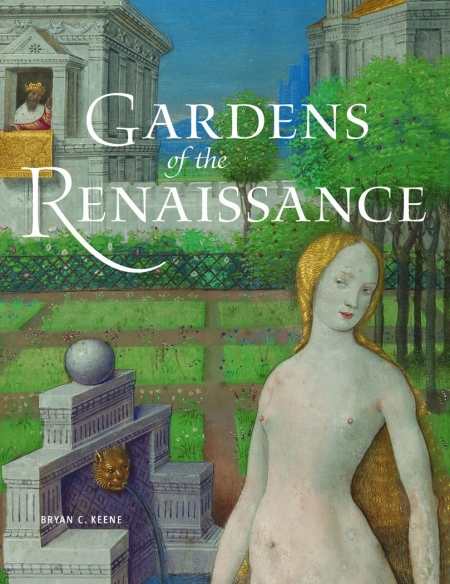Gardens of the Renaissance
Sumptuous illustrations are a look back in time, yet also an inspiration for the future.
The temptress Bathsheba is the cover girl for Getty Publications’ Gardens of the Renaissance, standing calmly naked with gleaming gold tresses while King David leers in the distance. Bathsheba Bathing, by French court artist Jean Bourdichon, is just one of sixty-four sumptuous illustrations in this petite companion volume to the J. Paul Getty Museum’s upcoming exhibit of the same name.
Author and Getty curatorial assistant Bryan C. Keene is a scholar of European manuscript illumination and the history of gardens, botany, and pharmacopoeia. His Gardens of the Renaissance is a fine blend of text and image that reads smoothly without seeming too heavy or academic.
As Keene details, gardens of this 1400 to 1600 AD time frame had significant influence. Renaissance noblemen bankrolled the creation of such stunning idylls, and they also sponsored the importing of then-exotic plants like the tulip and tomato. Herb cultivation allowed for advances in natural healing medicine, a practice still in use even in our antibiotic-reliant modern day. The beauty of Renaissance gardens invited courtly trysts and inspired works like Guillaume de Lorris’ Romance of the Rose, a chivalric classic dedicated to supreme love goddess Venus and a general advisory on how to win a lady’s heart.
Depictions of the original lovers, Adam and Eve, were common in Renaissance art, set amid verdant backdrops and ruined by that notoriously evil serpent. Portraits of Christ in the Renaissance garden offered themes of redemption and resurrection, just as the Virgin Mary was a symbol for purity. Flowers symbolizing the Virgin were often lilies and the peony, the peony being a “rose without thorns” of many petals and a sweet scent. And while Gardens of the Renaissance features a wonder of color illustrations, one of the most evocative images is a simple ink drawing of Christ as the Gardener, representing Jesus’ appearance to Mary Magdalene three days after his crucifixion.
As the current gardens of the Getty Center and Villa remind us, nature is eternally beautiful and a resource to be respectfully cultivated and enjoyed. The book includes illuminated botanical illustrations by Joris Hoefnagel, done circa 1591, but his bright sweet violet, voluptuous pea pod, and grace of a spider inching downward are as appealing and lifelike as today’s blooms, veggies, and web-weaving creatures. Gardens of the Renaissance is therefore a look back in time, yet also an inspiration for the future.
Reviewed by
Meg Nola
Disclosure: This article is not an endorsement, but a review. The publisher of this book provided free copies of the book to have their book reviewed by a professional reviewer. No fee was paid by the publisher for this review. Foreword Reviews only recommends books that we love. Foreword Magazine, Inc. is disclosing this in accordance with the Federal Trade Commission’s 16 CFR, Part 255.

